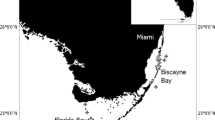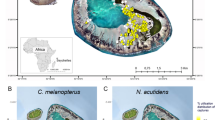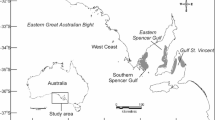Abstract
Predation is one of the most fundamental and unifying concepts in ecology, and we are beginning to obtain a more complete understanding of how predators drive community structure and ecosystem function through their impacts on prey. We know considerably less about how predators affect each other through intraguild interactions, which is surprising considering predators often occur simultaneously and may compete for resources while avoiding being killed themselves. In the present study, we examined aspects of inter- and intra-specific resource use among three species of large-bodied predatory sharks (blacktip, bull, lemon) co-occurring within a subtropical, protected bay in the southeastern USA. Specifically, we inferred relative trophic position, isotopic niche overlap, and patterns of resource use of sharks using stable isotope analysis of carbon-13 and nitrogen-15 from blood and fin cartilage samples. We also combined these approaches with estimates of abundance and occurrence from empirical shark surveys to consider whether these species may exhibit resource partitioning in space and time. We found that all three species overlapped in space, and there was some isotopic niche overlap between the species. We also found evidence of temporal isotopic niche stability, suggesting that co-occurring shark species may compete for available prey resources, but individuals of those species may have similar patterns of resource use over time. We discuss our findings as they relate to the ecologies of the species in question and how sound conservation and management of ecosystems can allow for predator diversity, sympatry, and stable use of resources at the top of the food chain.







Similar content being viewed by others
References
Abrantes KG, Barnett A (2011) Intrapopulation variations in diet and habitat use in a marine apex predator, the broadnose sevengill shark Notorynchus cepedianus. Mar Ecol Prog Ser 442:133–148
Barnett A, Semmens JM (2012) Sequential movement into coastal habitats and high spatial overlap of predator and prey suggest high predation pressure in protected areas. Oikos 121:882–890
Baum JK, Myers RA, Kehler DG, Worm B, Harley SJ, Doherty PA (2003) Collapse and conservation of shark populations in the Northwest Atlantic. Science 299:389–392
Beaudoin CP, Tonn WM, Prepas EE, Wassenaar LI (1999) Individual specialization and trophic adaptability of northern pike (Esox lucius): an isotope and dietary analysis. Oecologia 120:386–396
Byrnes J, Stachowicz JJ, Hultgren KM, Hughes RA, Olyarnik SV, Thornber CS (2006) Predator diversity strengthens trophic cascades in kelp forests by modifying herbivore behaviour. Ecol Lett 9:61–71
Chasar LC, Chanton JP, Koenig CC, Coleman FC (2005) Evaluating the effect of environmental disturbance on the trophic structure of Florida Bay, USA: multiple stable isotope analyses of contemporary and historical specimens. Limnol Oceanogr 50:1059
Cortés E (1999) Standardized diet compositions and trophic levels of sharks. ICES J Mar Sci 56:707–717
Costa DP (1993) The relationship between reproductive and foraging energetics and the evolution of the Pinnipedia. Symp Zool Soc Lond 66:293–314
Creel S, Christianson D (2008) Relationships between direct predation and risk effects. Trends Ecol Evol 23:194–201
Daly R, Smale MJ, Cowley PD, Froneman PW (2014) Residency patterns and migration dynamics of adult bull sharks (Carcharhinus leucas) on the east coast of southern Africa. PloS one 9:e109357
Dulvy NK et al (2014) Extinction risk and conservation of the world’s sharks and rays. eLife 3:ee590
Estes JA, Tinker MT, Williams TM, Doak DF (1998) Killer whale predation on sea otters linking oceanic and nearshore ecosystems. Science 282:473–476
Fisk AT, Tittlemier SA, Pranschke JL, Norstrom RJ (2002) Using anthropogenic contaminants and stable isotopes to assess the feeding ecology of Greenland sharks. Ecology 83:2162–2172
Frederiksen M, Edwards M, Richardson AJ, Halliday NC, Wanless S (2006) From plankton to top predators: bottom–up control of a marine food web across four trophic levels. J Anim Ecol 75:1259–1268
Frisch AJ et al (2016) Reassessing the trophic role of reef sharks as apex predators on coral reefs. Coral Reefs 35:459–472
Gallagher AJ, Kyne PM, Hammerschlag N (2012) Ecological risk assessment and its application to elasmobranch conservation and management. J Fish Biol 80:1727–1748
Gallagher AJ, Serafy JE, Cooke SJ, Hammerschlag N (2014) Physiological stress response, reflex impairment, and survival of five sympatric shark species following experimental capture and release. Mar Ecol Prog Ser 496:207–218
Gallagher AJ, Skubel RA, Pethybridge HR, Hammerschlag N (2017) Energy metabolism in mobile, wild-sampled sharks inferred by plasma lipids. Conserv Physiol 5(1):cox002
Ghalambor CK, Martin TE (2000) Parental investment strategies in two species of nuthatch vary with stage-specific predation risk and reproductive effort. Anim Behav 60:263–267
Graham F, Rynne P, Estevanez M, Luo J, Ault JS, Hammerschlag N (2016) Use of marine protected areas and exclusive economic zones in the subtropical western North Atlantic Ocean by large highly mobile sharks. Div Distrib 22:534–546
Hammerschlag N, Serafy JE (2010) Nocturnal fish utilization of a subtropical mangrove–seagrass ecotone. Mar Ecol Prog Ser 31:364–374
Hammerschlag N, Luo J, Irschick DJ, Ault JS (2012) A comparison of spatial and movement patterns between sympatric predators: bull sharks (Carcharhinus leucas) and Atlantic tarpon (Megalops atlanticus). PLoS ONE 7:e45958
Hammerschlag-Peyer CM, Yeager LA, Araújo MS, Layman CA (2011) A hypothesis-testing framework for studies investigating ontogenetic niche shifts using stable isotope ratios. PLoS ONE 6:e27104
Hawlena D, Pérez-Mellado V (2009) Change your diet or die: predator-induced shifts in insectivorous lizard feeding ecology. Oecologia 161:411–419
Heithaus MR, Hamilton IM, Wirsing AJ, Dill LM (2006) Validation of a randomization procedure to assess animal habitat preferences: microhabitat use of tiger sharks in a seagrass ecosystem. J Anim Ecol 75:666–676
Heupel MR, Simpfendorfer CA, Hueter RE (2003) Running before the storm: blacktip sharks respond to falling barometric pressure associated with Tropical Storm Gabrielle. J Fish Biol 63:1357–1363
Hoffmayer ER, Parsons GR (2003) Food habits of three shark species from the Mississippi Sound in the northern Gulf of Mexico. Southeast Nat 2:271–280
Hussey NE, MacNeil MA, Fisk AT (2010) The requirement for accurate diet-tissue discrimination factors for interpreting stable isotopes in sharks. Hydrobiologia 654:1–5
Hussey NE, Dudley SF, McCarthy ID, Cliff G, Fisk AT (2011) Stable isotope profiles of large marine predators: viable indicators of trophic position, diet, and movement in sharks? Can J Fish Aquat Sci 68:2029–2045
Hussey NE et al (2012) Stable isotopes and elasmobranchs: tissue types, methods, applications and assumptions. J Fish Biol 80:1449–1484
Jackson AL, Inger R, Parnell AC, Bearhop S (2011) Comparing isotopic niche widths among and within communities: SIBER–Stable Isotope Bayesian Ellipses in R. J Ani Ecol 80:595–602
Kim SL, Koch PL (2012) Methods to collect, preserve, and prepare elasmobranch tissues for stable isotope analysis. Environ Biol Fish 95:53–63
Kinney MJ, Hussey NE, Fisk AT, Tobin AJ, Simpfendorfer CA (2011) Communal or competitive? Stable isotope analysis provides evidence of resource partitioning within a communal shark nursery. Mar Ecol Prog Ser 439:263–276
Kiszka JJ, Aubail A, Hussey NE, Heithaus MR, Caurant F, Bustamante P (2015) Plasticity of trophic interactions among sharks from the oceanic south-western Indian Ocean revealed by stable isotopeand mercury analyses. Deep Sea Res Part I Oceanogr Res Pap 96:49–58
Knudsen R, Siwertsson A, Adams CE, Garduño-Paz M, Newton J, Amundsen PA (2011) Temporal stability of niche use exposes sympatric Arctic charr to alternative selection pressures. Evol Ecol 25:589–604
Layman CA, Arrington DA, Montaña CG, Post DM (2007) Can stable isotope ratios provide for community-wide measures of trophic structure? Ecology 88:42–48
Layman CA et al (2012) Applying stable isotopes to examine food web structure: an overview of analytical tools. Biol Rev 87:542–562
Lima SL, Dill LM (1990) Behavioral decisions made under the risk of predation: a review and prospectus. Can J Zool 68:619–640
Lucas JR, Walter LR (1991) When should chickadees hoard food? Theory and experimental results. Anim Behav 41:579–601
MacNeil MA, Skomal GB, Fisk AT (2005) Stable isotopes from multiple tissues reveal diet switching in sharks. Mar Ecol Prog Ser 302:199–206
Madin EM et al (2010) Field evidence for pervasive indirect effects of fishing on prey foraging behavior. Ecology 91:3563–3571
Matassa CM, Trussell GC (2011) Landscape of fear influences the relative importance of consumptive and nonconsumptive predator effects. Ecology 92:2258–2266
Matich P, Heithaus MR, Layman CA (2011) Contrasting patterns of individual specialization and trophic coupling in two marine apex predators. J Anim Ecol 80:294–305
Newman SP, Handy RD, Gruber SH (2009) Diet and prey preference of juvenile lemon sharks Negaprion brevirostris. Mar Ecol Prog Ser 398:221–234. doi:10.3354/meps08334
Ortega LA, Heupel MR, Van Beynen P, Motta PJ (2009) Movement patterns and water quality preferences of juvenile bull sharks (Carcharhinus leucas) in a Florida estuary. Environ Biol Fish 84:361–373
Papastamatiou YP, Wetherbee BM, Lowe CG, Crow GL (2006) Distribution and diet of four species of carcharhinid shark in the Hawaiian Islands: evidence for resource partitioning and competitive exclusion. Mar Ecol Prog Ser 320:239–251
Papastamatiou YP, Friedlander AM, Caselle JE, Lowe CG (2010) Long-term movement patterns and trophic ecology of blacktip reef sharks (Carcharhinus melanopterus) at Palmyra Atoll. J Exp Mar Biol Ecol 386:94–102
Papastamatiou YP, Meyer CG, Kosaki RK, Wallsgrove NJ, Popp BN (2015) Movements and foraging of predators associated with mesophotic coral reefs and their potential for linking ecological habitats. Mar Ecol Prog Ser 521:155–170
Peterson BJ, Fry B (1987) Stable isotopes in ecosystem studies. Ann Rev Ecol Syst 18:293–320
Post DM (2002) Using stable isotopes to estimate trophic position: models, methods, and assumptions. Ecology 83:703–718
R Core Team (2013) R: A language and environment for statistical computing. R Foundation for Statistical Computing, Vienna, Austria. http://www.R-project.org/
Roff G et al (2016) The ecological role of sharks on coral reefs. Trends Ecol Evol 31:395–407
Shiffman DS, Gallagher AJ, Boyle MD, Hammerschlag-Peyer CM, Hammerschlag N (2012) Stable isotope analysis as a tool for elasmobranch conservation research: a primer for non-specialists. Mar Fresh Res 63:635–643
Shiffman DS, Frazier B, Kucklick J, Abel D, Brandes J, Sancho G (2014) Feeding ecology of the sandbar shark (Carcharhinus plumbeus) in South Carolina estuaries revealed through δ13C and δ15N stable isotope analysis. Mar Coast Fish 6:156–169
Silliman BR, Bertness MD (2002) A trophic cascade regulates salt marsh primary production. Proc Nat Acad Sci 99:10500–10505
Simpfendorfer CA, Milward NE (1993) Utilisation of a tropical bay as a nursery area by sharks of the families Carcharhinidae and Sphyrnidae. Environ Biol Fish 37:337–345
Snelson FF, Mulligan TJ, Williams SE (1984) Food habits, occurrence, and population structure of the bull shark, Carcharhinus leucas, in Florida coastal lagoons. Bull Mar Sci 34:71–80
Speed CW, Meekan MG, Field IC, McMahon CR, Abrantes K, Bradshaw CJA (2012) Trophic ecology of reef sharks determined using stable isotopes and telemetry. Coral Reefs 31:357–367
Springer S (1961) Dynamics of the feeding mechanism of large galeoid sharks. Am Zool 1:183–185
Torres LG, Heithaus MR, Delius B (2006) Influence of teleost abundance on the distribution and abundance of sharks in Florida Bay, USA. Hydrobiologia 569:449–455
Turner TF, Collyer ML, Krabbenhoft TJ (2010) A general hypothesis-testing framework for stable isotope ratios in ecological studies. Ecology 91:2227–2233
Vaudo JJ, Heithaus MR (2012) Diel and seasonal variation in the use of a nearshore sandflat by a ray community in a near pristine system. Mar Fresh Res 63:1077–1084
Vizzini S, Mazzola A (2003) Seasonal variations in the stable carbon and nitrogen isotope ratios (13C/12C and 15N/14N) of primary producers and consumers in a western Mediterranean coastal lagoon. Mar Biol 142:1009–1018
Werner EE, Peacor SD (2003) A review of trait-mediated indirect interactions in ecological communities. Ecology 84:1083–1100
Werry JM, Lee SY, Lemckert CJ, Otway NM (2012) Natural or artificial? Habitat-use by the bull shark, Carcharhinus leucas. PLoS ONE 7:e49796
White WT, Potter IC (2004) Habitat partitioning among four elasmobranch species in nearshore, shallow waters of a subtropical embayment in Western Australia. Mar Biol 145:1023–1032
Wiley TR, Simpfendorfer CA (2007) The ecology of elasmobranchs occurring in the Everglades National Park, Florida: implications for conservation and management. Bull Mar Sci 80:171–189
Yeiser BG, Heupel MR, Simpfendorfer CA (2008) Occurrence, home range and movement patterns of juvenile bull (Carcharhinus leucas) and lemon (Negaprion brevirostris) sharks within a Florida estuary. Mar Fresh Res 59:489–501
Acknowledgements
We are grateful for the field support provided by D. Lazarre, V. Ansaldi, C. Shepard, as well as the rest of the interns and staff from the Shark Research and Conservation Program at the University of Miami. We also thank L. Sternburg for his assistance during laboratory assays. We thank C. Rohner and P. Prebble for their constructive comments on this submission. This work was supported by the Batchelor Foundation Inc., the Disney Conservation Fund, and the University of Miami Citizen’s Board. All of the work here conformed to the legal requirements in the USA and was permitted and conducted under the Everglades National Park Permit (EVER-2011-SCI-0012), and the University of Miami Institutional Animal Care and Use Committee (Protocol # 09–187).
Author information
Authors and Affiliations
Corresponding author
Ethics declarations
Conflicts of interest
The authors declare no conflicts of interest, and all authors gave consent.
Additional information
Handling Editor: Piet Spaak.
Rights and permissions
About this article
Cite this article
Gallagher, A.J., Shiffman, D.S., Byrnes, E.E. et al. Patterns of resource use and isotopic niche overlap among three species of sharks occurring within a protected subtropical estuary. Aquat Ecol 51, 435–448 (2017). https://doi.org/10.1007/s10452-017-9627-2
Received:
Accepted:
Published:
Issue Date:
DOI: https://doi.org/10.1007/s10452-017-9627-2




